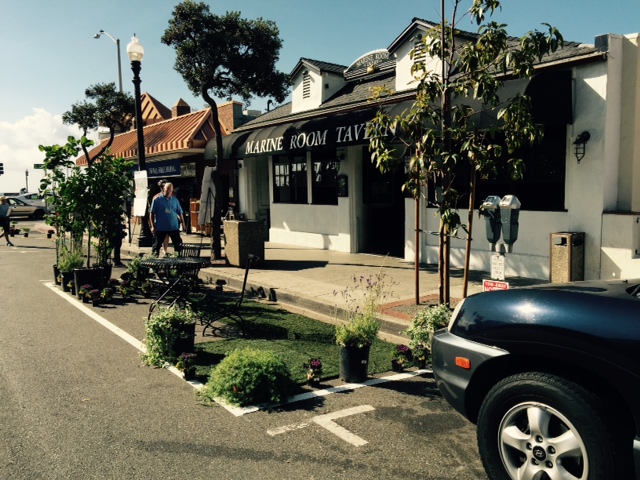
Merchants effectively succeeded in lobbying to postpone a trial closure of lower Forest Avenue, though the City Council did vote Tuesday to temporarily transform six parking spaces on Forest and Ocean Avenues into outdoor dining areas for 60 days beginning in mid-September. Whole Foods made a successful bid for creating a seating area in a portion of their lot, as well.
Another proposal to close lower Ocean Avenue to accommodate the Saturday farmers’ market, evicted from its usual location for sewer repairs from September to May, also received a makeover. Staff will instead investigate shifting the market to Second Avenue for a portion of that time and to the upper lot in the Glenneyre Street parking structure for the remainder.
These so-called pilot demonstrations grew out of the city’s ongoing effort to update the downtown specific plan that sets the parameters for development downtown. The City Council selected San-Diego-based MIG last summer to assist this effort by studying options for improving circulation and economic vibrancy as well as gathering public input on possible changes.
The trial concepts are intended to inform potential planning recommendations.
But the concepts – especially the proposed 13-day trial closure of Forest Avenue at the end of August – ran headlong into opposition from merchants when staff presented the plan at a workshop earlier this month. The backlash had not abated at Tuesday’s hearing.
Village Laguna’s president Johanna Felder called the temporary closure “a plan in search of a problem,” and criticized MIG for not doing their homework.
Some residents brought up studies claiming pedestrian malls were doomed to failure. Why try to fix Forest Avenue when it’s not broken? others asked.
Resident Bill Hoffman countered with a finding by the Urban Land Institute that retail sales go up where pedestrian amenities are improved.
Even so, supporters for creating a pedestrian mall were far outnumbered Tuesday by angry merchants protesting that even a brief street closure could have potentially devastating effects on their bottom line. Several pointed out that previous closures, such as for the Craft Guild, proved that special activities drew crowds but failed to yield customers entering shops.
Instead of a street closure to invigorate downtown, what they really needed was a parking structure, many said.
In turn, Mayor Bob Whalen, who called for a citywide parking strategy, expressed his frustration with merchants who demonstrated “virtually no support” for a parking structure originally included in recent plans to beautify the village entrance when it was hotly contested and finally dropped.
Whalen also lamented the negative reaction to the pilot demonstrations. “The forces of no in this community are just overwhelming sometimes,” he said. “What we’re talking about here is some experimentation with a couple of trials, and if you can’t live with a little change in your lives for a couple of weeks, I say, oh my goodness, let’s get a grip here.”
It did not help that MIG’s Rick Barrett did not appear to fully appreciate some of the hurdles Council members and others highlighted.
While public feedback on the trial concepts will be measured, perhaps with an online survey option and comment cards, Barrett admitted that they had no way to objectively measure its affect on retailers unless the merchants themselves volunteered to share sales data.
Council member Steve Dicterow also asked about the potential for a pedestrian mall to attract people who might loiter. Barrett suggested that it could take “a certain amount of policing.”
Council member Toni Iseman noted that at the earlier workshop MIG lacked answers about how the street closure would affect merchants, how many parking spaces would be forfeited and how circulation would be affected. “We rely on experts and we need some better input here,” she said.
And Billy Fried took MIG to task for a poorly communicated appeal to merchants, presenting the proposed closure as a festival atmosphere. “What we’re talking about is simply a public square with no programming, just public seating and landscaping to make it more beautiful,” he said. A real pedestrian plaza doesn’t draw people to a party atmosphere, but actually draws them to linger longer and windowshop, he said. “We won’t know until we test this and have the courage to try it.”
Correction: The article “Forest Closure Kicked to the Curb” incorrectly describes the road considered to relocate the farmer’s market. It is Second Street; Second





[…] Avenues to generate business and increase pedestrian use and enjoyment of these two streets was a hot topic. I was shocked at the idea to relocate farmer’s market to Ocean Avenue. The current location is […]
[…] you get over the parking issue, it would add a sense of excitement downtown,” Hoffman said. “Forest Avenue is not reaching its […]